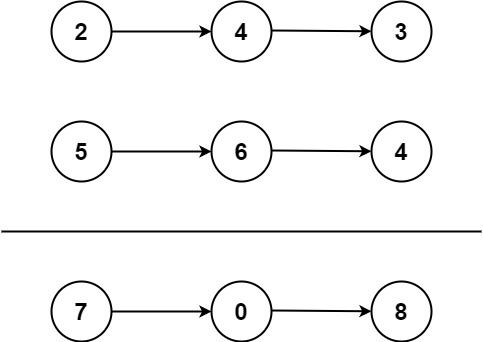-
Difficulty: Medium
-
Related Topics: Linked List, Math
Description
You are given two non-empty linked lists representing two non-negative integers. The digits are stored in reverse order, and each of their nodes contains a single digit. Add the two numbers and return the sum as a linked list.
给定两个非空链表表示两个整数。整数的每一位倒序存储,链表内的每一个节点仅包含一个数字,将这两个数相加,以单链表的形式返回答案。
You may assume the two numbers do not contain any leading zero, except the number 0 itself.
你可以假定除了 0 本身外,两数都不含前导 0。
Examples
Example 1

Input: l1 = [2,4,3], l2 = [5,6,4]
Output: [7,0,8]
Explanation: 342 + 465 = 807.
Example 2
Input: l1 = [0], l2 = [0]
Output: [0]
Example 3
Input: l1 = [9,9,9,9,9,9,9], l2 = [9,9,9,9]
Output: [8,9,9,9,0,0,0,1]
Constraints
- The number of nodes in each linked list is in the range
[1, 100]. 0 <= Node.val <= 9- It is guaranteed that the list represents a number that does not have leading zeros.
Solution
做这题的时候需要注意两点:
-
两数长度不一样时的处理;
-
相加到最后的进位处理。
得益于 Kotlin 对可空元素的语法糖,我不需要单独考虑第一种情况,代码如下:
/**
* Example:
* var li = ListNode(5)
* var v = li.`val`
* Definition for singly-linked list.
* class ListNode(var `val`: Int) {
* var next: ListNode? = null
* }
*/
class Solution {
fun addTwoNumbers(l1: ListNode?, l2: ListNode?): ListNode? {
var p = l1
var q = l2
val dummy = ListNode(-1)
var r: ListNode? = dummy
var carry = 0
while (p != null || q != null) {
val digit = (p?.`val`?:0) + (q?.`val`?:0) + carry
carry = digit / 10
r?.next = ListNode(digit % 10)
r = r?.next
p = p?.next
q = q?.next
}
if (carry != 0) {
r?.next = ListNode(carry)
}
return dummy.next
}
}